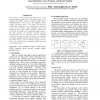Free Online Productivity Tools
i2Speak
i2Symbol
i2OCR
iTex2Img
iWeb2Print
iWeb2Shot
i2Type
iPdf2Split
iPdf2Merge
i2Bopomofo
i2Arabic
i2Style
i2Image
i2PDF
iLatex2Rtf
Sci2ools
ICRA
2003
IEEE
2003
IEEE
Towards a dynamic actuator model for a hexapod robot
We describe a model predicting the output torque of the battery-amplifier-actuator-gear combination used on the hexapod robot RHex, based on requested PWM (PulseWidth-Modulation) duty cycle to the amplifier, battery voltage, and motor speed. The model is broken into independent components, each experimentally validated: power source (battery), motor amplifier, motor, and (planetary) gear. The resulting aggregate model shows <6 % Full Scale RMS error in predicting output torque in the first quadrant of operation (positive torques). Understanding the key ingredients and the attainable accuracies of torque production models in our commonly used battery-amplifier-actuator-gear combinations is critical for mobile robots, in order to minimize sensing, and thus space, size, weight, power consumption, failure rate, and cost of mobile robots. Keywords— DC permanent magnet brush motor, PWM, planetary gear, current, voltage, model, hexapod, robot
Battery-amplifier-actuator-gear Combinations | Hexapod Robot Rhex | ICRA 2003 | Output Torque | Robotics |
| Added | 04 Jul 2010 |
| Updated | 04 Jul 2010 |
| Type | Conference |
| Year | 2003 |
| Where | ICRA |
| Authors | Dave McMordie, Chris Prahacs, Martin Buehler |
Comments (0)

